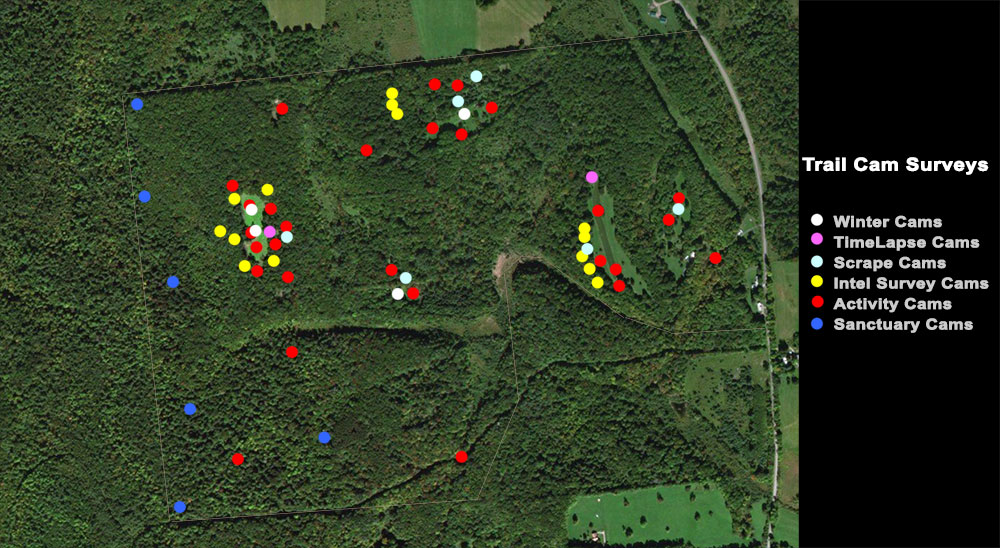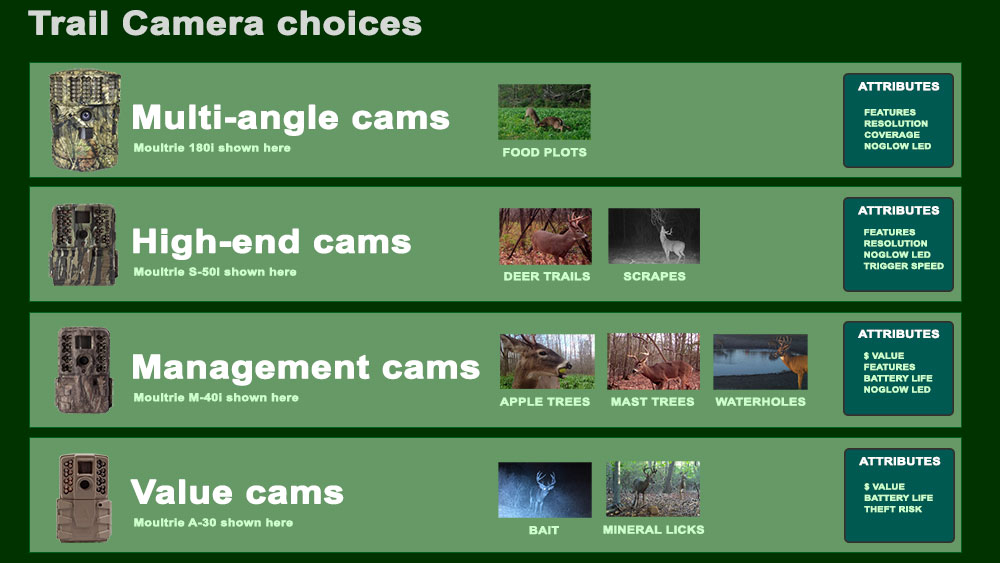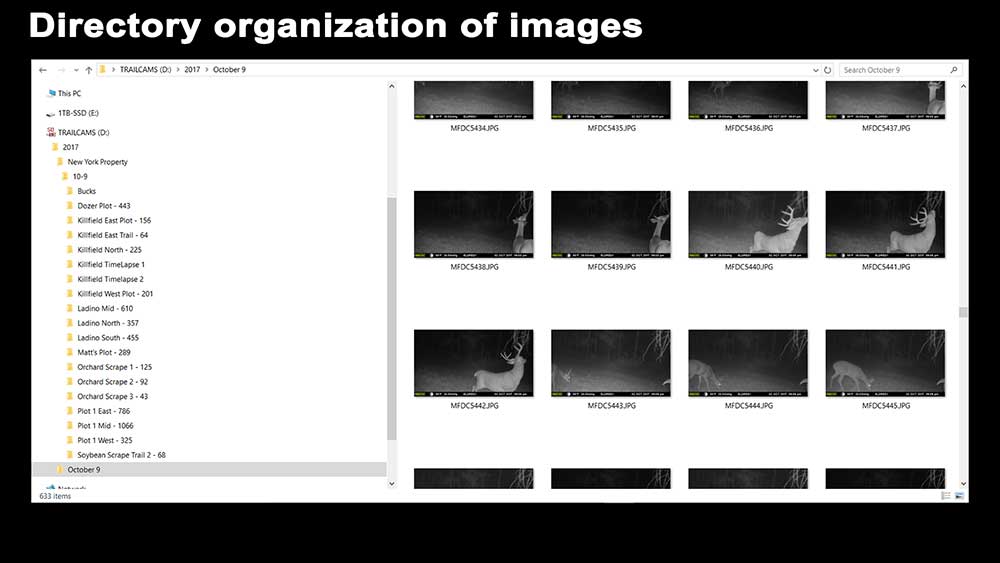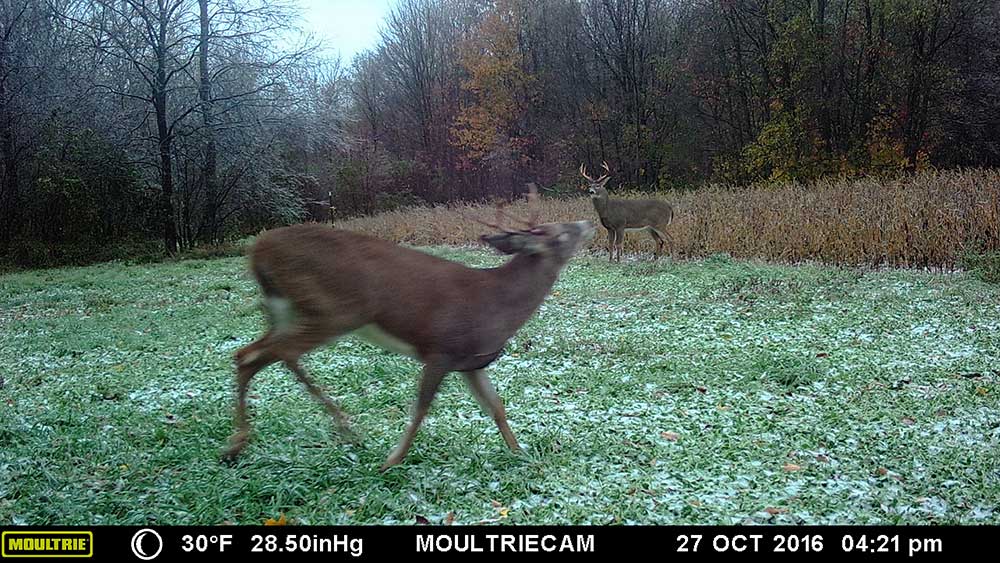A crash course in Trail Camera Surveys
Discuss this feature
A few years ago, a rifle hunter took a magnificent buck on the neighboring property. None of the locals had seen the buck before. They surmised it had wandered out of the Adirondacks and past the lucky hunter. That notion was false. I knew the buck well and had watched him for three years. By the time he was killed I could tell you where he fed given the month, the boundaries he moved in, and the buck he considered his arch rival. I even had him in range twice - but just couldn't get a clean bow shot. Not only did I know this buck intimately, I also knew there was a bigger one that my son would kill the following year.
So how did I know so much about these bucks, and virtually every other buck on my land? Trail camera surveys.
Anyone who does land management and cultivates properties for whitetail deer know about trail camera surveys. I'll break this down into two options; extreme surveys - where you identify patterns, and nearly every buck on your property, and basic surveys - where we will show you how to optimize a small number of cameras to get a good sample of deer activity and individual bucks.
Both types of surveys break down into three main objectives:
-
Identifying individual bucks including shooters
-
Understanding deer movement and feeding patterns
-
Assessing pressure including predation and hunting
Let's start by defining the simple difference between an extreme survey and a basic survey. Basically, it boils down to the quantity of trail cameras you deploy and manage on your deer hunting property.
Extreme Surveys
Extreme surveys dramatically speed up the process of learning a property. It allows you to understand what food sources are hot at a given time, when bucks roll in and out of your property, when rutting phases begin and end, and how deer react to pressure. It's an effective tool that can teach you things about your property which are both educational and fascinating.
On my 312 acres in NY, I run 30-40 trail cameras. They are not all new, nor are they all expensive. I use different cameras for different objectives. On my extreme survey I break down my cam functions into these categories:
Activity Cams - these are generally placed near food sources and trails in likely locations. They are there to detect activity in food plots and to spot individual bucks.
Time-lapse Cams - I deploy a couple time-lapse cams per year and only when I am having a hard time pinpointing ingress and egress points on crop fields.
Scrape Cams - when the scrapes appear, the scrape cams go up. I use higher end cams for this objective set at high resolution. I generally choose the camera setting of Both so it takes a photo, followed by a video clip. This provides incredible intel on your bucks and helps gauge rut phases.
Sanctuary Cams - I set these in the summer and pick them up the following spring. They are for long-term survey purposes only and provide an idea on how deer use escape trails and security cover. Obviously, we don't check these cams during the hunting season unless necessary. Since these cams stay out most of the year, I only use Lithium-Ion batteries, and at least 8mb SD cards with photo quality set to Medium.
Winter Cams - these cams are either left in place, or specifically placed after the season is over. I consider these my most interesting (vital?) cams as they help indicate which bucks survived the hunting season. I place these cams on brassica plots specifically planted for winter nutrition and attraction.
Intel Cams - this is a set of inexpensive cams that are placed on primary and secondary trails leading to popular food sources. The key here is to identify the most heavily used deer trails and the secondary buck trails along rub and scrape lines. I will use several cameras for this purpose but as soon as I answer whatever question I am asking, the cams generally come down and moved elsewhere.

The above graphic illustrates how I deploy an extreme trail cam survey on my NY property.
Basic Surveys
Basic surveys use 1-5 trail cameras and can be used on any sized property. The larger the property, the less reliable your survey becomes. I have three properties where I conduct basic surveys and while you will never achieve a comprehensive understanding - like you can with an extreme survey - they will help you with two objectives; identifying some individual bucks including shooters, and getting a feel for feeding activity and some movement patterns.
The below examples show you how I deploy basic surveys on three very different hunting properties.
Real-world Basic Surveys
8-acre CT Property - Baiting allowed: I have an 8-acre suburban deer hunting property that I hunt in Southwest Connecticut. Baiting is legal and the property is too small for anything other than one activity cam that overlooks the bait. For this property I use (1) Moultrie M-40i attached to a Moultrie Mobile Modem. That trail camera goes up in October and stays up until antlers drop in February.
30-acre PA Property with (1) Food Plot: On this property baiting is not allowed but I always have one quality food plot and generally one producing apple tree. I run (3) cams on this property. A Moultrie 180i captures 180 degrees in the middle of the food plot for activity. A Moultrie M-40i captures the East main trail, and a Moultrie S-50i watches a scrape that appears every year at the apple tree. I attach a Moultrie Mobile unit to the S-50i. This allows me to gauge both apple and scrape activity and watch from afar. I hunt there for one week, then I pull the M-40i, S-50i, and modem. I put fresh Li-Ion batteries in my food plot 180i and leave it there until I return the following spring.
83-acre CT Property with a big cornfield: This property presents a challenge since the cornfield takes up a third of the property. I run (4) Moultrie A-30 cams and (1) M-40i cam during October and November only. I run mostly inexpensive cams here since trail cam theft is possible. I have two A-30 cams overlooking well-worn deer trails leading from bedding areas to the cornfield, two A-30i cams on the first two scrapes of the season, and one M-40i mounted 10' up a tree set to Time-Lapse to get an overview of the most remote corner of the cornfield. I leave these cams up until the weekend before rifle then I pull them out.
Maximizing trail camera efficiency
Even if you own 40 trail cameras and your hunting property is only 40 acres, you must carefully choose where to deploy those units to maximize your survey. I have been doing trail cam surveys for well over a decade and I've found these locations make up my Top 8 locations for trail camera placement (shown in priority order).

Note: the above information has geographic implications. Waterholes will be a higher priority for western whitetails, and fruit and mast trees may not exist in your location.
Picking the best trail camera for the job
While all trail cameras will work to some degree, some cameras work better than others. I don't reach into a bin and grab the first available trail camera, I am deliberate with each cam that I choose. Using my top 8 list above, here's the cameras I would choose for each objective and why.

My first bias is always cost. Like everyone else I need to be smart about my trail camera purchases. Sometimes cost is secondary to coverage, trigger speed, or resolution. For example, I don't like to use single-angle trail cams in food plots. I prefer to use multi-angle Panoramic cams like Moultrie's 180i that can detect and capture a full 180 degrees. I will note that I almost never run them in 'Panoramic' mode. Instead I run them in traditional mode where a standard picture is taken from whatever sensor is tripped. I can cover far more area using these cameras.
Other considerations may come into play. I don't hunt public land, but if I did I would use the oldest cams I have (or the least expensive cams I could buy) because the risk of theft is far greater on public land. On trails, I like using cams with fast trigger speeds (for example, the 2017 Moultrie M-40i has a .03 trigger) and on areas where I am sensitive to disturbing deer, like scrapes or apple trees, I always prefer no-glow LEDs.
Managing images and learning from them
Placing cams and capturing images is only part of the process. The other part is managing all that data and learning from it. I know hunters who maintain excel spreadsheets and personal databases. I admire those guys, but I'm not one of them. While I save every one of the 30-40k photos I will collect in any given year, I am more interested in the the Big picture rather than the individual picture.
On my NY property the objective is much more than hunting - it's basically a master's degree program in deer behavior. I am primarily focused on the three objectives above (identification, patterns, and pressure) so I am looking at my photos through that lens.

My first step in the review process is to create a Top directory named by Year. I then break the directory down by location - like New York Property. From there, every time I review a batch of chips I save them to a directory labeled by creation date M/DD. See the photo above from last week. I created a directory called 10-9. Under the 10-9 directory, I create a new directory called "Bucks." As I review each individual chip I copy and paste all my mature buck photos into the 'Bucks' directory. All remaining images are copied into a subdirectory that labels the location, followed by the number of images. For example, I run 3 cameras on my Ladino food plot. One of those directories may be named Ladino South - 455 (representing the cam position, and number of photos captured).
It sounds complicated, but it's not. I check my cams roughly once per month and it takes me about 2 hours to organize and copy my photos. Once the photos are copied, I format the card and put them into a medication dispenser which holds all my clean chips.
But beyond the organization of images, As I rapidly flip through every photo, I am looking for individual bucks, at the same time I am making a note of the 'big picture.' That includes learning what plots are hot at certain periods, when the scrapes heat up, and cool down, and whether I am seeing new deer show up, or past deer that are missing.
Is this Fair?
I am sure some of you reading this are asking how much does it cost to buy and run 40 cameras, 40 SD Cards, and feeding them batteries? Or the philosophical question; is this fair?
If you are the kind of person who wants to be surprised by the 8 point that just appeared in front of your stand then surveys are not for you. Same if you are a meat hunter. If you find whitetail deer fascinating and you're driven by what they teach you then I'd say you're a good candidate.
Nobody I know expends the amount of money and time necessary to run extreme trail camera surveys so they can kill more deer. It's their passion for whitetails, and desire to learn that drives us, not the kill. I am also of the opinion that if hunters knew the quality of mature, solitary bucks that frequent their property many may hold off on killing subordinate bucks. This is QDM 101. In six seasons of owning my property, I have killed only two deer. I could have killed 20 bucks in that same period of time. Knowing there were some real bruisers frequenting the property made the decision to pass smaller bucks easier.
I am sure there are purists that think all these trail cams is making it easier for people to kill deer, I would dispute that notion - any day of the week.
Conclusion
In five years I have learned more from my cams than a lifetime of sitting in stands. It's opened up a new and exciting aspect to hunting that goes far beyond the kill. Getting to know your individual bucks and following them year after year is fascinating. It also allows me to focus on just one or two animals, so I'm punching far less tags but have a greater satisfaction from my hunts.

The buck I'm after this year is a 6.5-year-old 10, he is entirely nocturnal, never visits scrapes, and only captured on cams between 2AM and 5AM. He beds in an area that is inaccessible and only approaches food plots from the downwind side. He likes company too, he only hits fields when other deer are already feeding on those crops.
My surveys told me all that. They also tell me that I have virtually no chance of killing him, but I'm going to try anyway. It makes the challenge that much more interesting.




